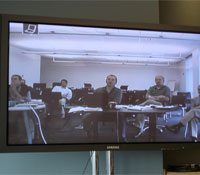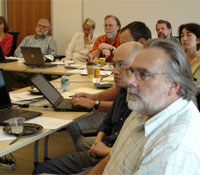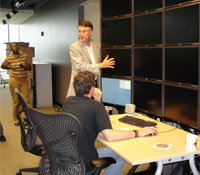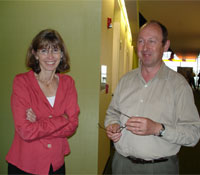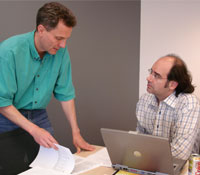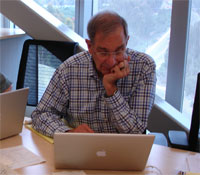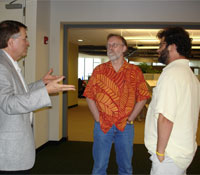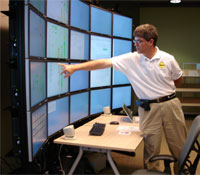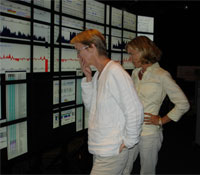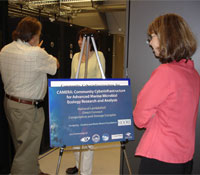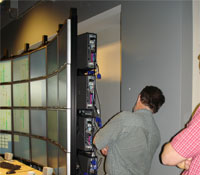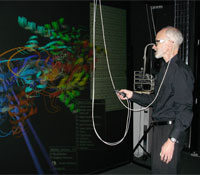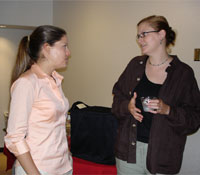Microbial Metagenomics Project Holds First Science Advisory Board Meeting
By Stephanie Sides
6.13.2006 -- Nine members of CAMERA’s Science Advisory Board joined 16 others present from Calit2, the J. Craig Venter Institute (JCVI), and the Moore Foundation and as many as six virtually from JCVI for two days of meetings last week to hear about progress to date and suggest policy, process, and directions for this marine microbial metagenomics project. CAMERA is the acronym used for the Community Cyberinfrastructure for Advanced Marine Microbial Ecology Research and Analysis, supported by a $24.5M award over seven years from the Gordon and Betty Moore Foundation.
|
|
Mary Ann Moran, professor of Marine Sciences at the University of Georgia, and David Kingsbury, chief program officer from the Moore Foundation, co-chaired the meeting.
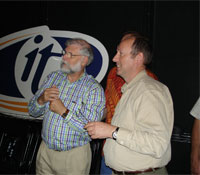 |
|
David Kingsbury (Moore Foundation) and Paul Gilna (new executive director of CAMERA)
|
“The goal of this meeting was to gather input from the Science Advisory Board on how the scientific community might best use CAMERA," said Kingsbury. "We wanted specific details from the people who are most likely to use this system such as: what metadata should be available, how to access the system, and what tools should be included.”
One of the main goals of this project is to provide the scientific community with a data repository supported by computing hardware, software tools, and networking resources in partnership with world leaders conducting complementary projects. Annual meetings for this technically engaged and lively group will help ensure CAMERA success.
|
Said Larry Smarr, PI of the project, “This is a pivotal moment for CAMERA: While the project is still in a formative stage, we're bringing in scientists in microbial metagenomics from around the country so that they can advise us and we can make adjustments to serve the community.”
Said Paul Gilna, newly hired executive director of CAMERA, “We're looking to the Science Advisory Board to have a strong influence on the directions we take.”
The CAMERA development team is interested in scientific questions SAB members have but can't answer today and questions they think they might want to answer in the future. What are the roadblocks they're dealing with with respect to metagenomic data? What roadblocks do they anticipate?
Key issues, which provoked lots of discussion, focused on the need for development of community standards, what set of metadata should be collected, what types of users (that is, what range of user sophistication) should be supported, how access should be provided, the best ways to acquaint the community with this resource, and technical details about the release schedule staged over the next several years.
The project is in a “sprint” phase, which includes early planning/operations, publication of data associated with the Global Ocean Survey (GOS) data being collected by JCVI and microbe studies funded by the Moore Foundation to underpin a set of publications to appear this summer, and definition of early deliverables. The following “marathon” phase will focus on collecting and applying community input to drive prioritization of project tasks.
The first release (0.5) is scheduled for August. Release 1.0, scheduled for the fall, is being designed to have maximum impact on a short timeline, providing a strong foundation for enhancements to come. It will include the initial architecture and underlying database, enable retrieving and applying BLAST searches to the GOS dataset, support high-priority workflows, provide interactive graphical views, and enable users to generate their own views to support scientific progress and publication of results.
Dedicated infrastructure for this project includes a Web portal that will provide access to a dedicated compute farm of 1,000 CPUs (that will not require users to parallel program), a database farm (size yet to be determined) with various database representations, and a flat file server farm (estimated at 100s of TB).
This infrastructure will be connected over dedicated 10-Gbps links to the rest of the world. CAVEWave now connects San Diego through Seattle to Chicago and on to Washington, DC. This link is being extended 25 miles to JCVI in Rockville, Maryland, from the link in place to NASA Goddard. The CAMERA project intends to hold a workshop this summer to generate interest among potential users.
The team is also developing a commodity 4x5 tiled display wall for visualizing and interacting with the data. The first model was constructed the week before last and demonstrated to the SAB at the meeting.
This project has excited considerable interest in the scientific and engineering world because it may help explain the past and engineer solutions to daunting problems in the world today. On the one hand, microbes are considered by many to be the foundation of all life on the planet. Understanding more about them is likely to help flesh out the Tree of Life and evolutionary biological processes.
|
|
|
|
|
|
On the other hand, greater understanding of microbial evolution, structure, and function might be used to engineer specific types of microbes with specific functions to help address problems such as pollution, global warming, and the lack of renewable energy. This capability, in turn, might lead to development of predictive models, which some consider the Holy Grail of the environmental metagenomics community.


